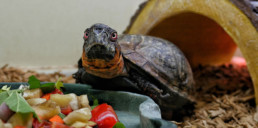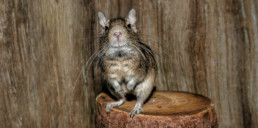Live Animal Room
Get A Closer Look At Nature
Whether you’re coming face to face with a monitor lizard, petting a snake for the first time, finding a tarantula hidden in its web, or watching turtles enjoy a swim, there is always something new to experience in the North Museum’s Live Animal Room.


Featured Exhibit – Degus
Say hello to the Live Animal Room’s only furry residents. Degus are commonly called bush-tailed rats, but are more closely related to guinea pigs and chinchillas than to the rats commonly found in most American cities. They even take dust baths like chinchillas do! In the wild, degus can be found in the semi-arid scrub areas of central Chile, specifically along the lower western slopes of the Andes Mountains. Degus are diurnal and highly social. Females from the same social group often raise their babies (called pups) together in a common burrow. Our three degus are sisters from the same litter. Their favorite thing to do is spin in their wheel, and their favorite food is oats.
North Museum Science & Engineering Fair
Support innovative student scientists who are changing the world.


